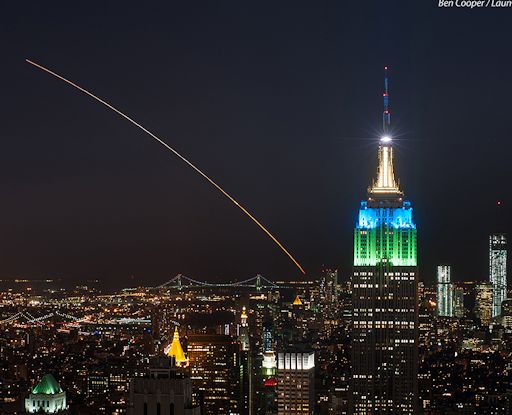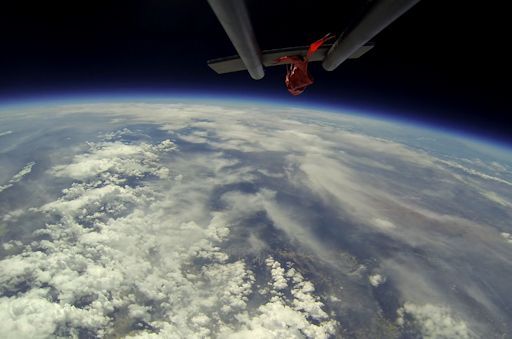Listen to radar echoes from satellites and meteors, live on listener-supported Space Weather Radio. | | |
QUIET SUN: Solar activity remains low. All of the sunspots on the Earthside of the sun are stable and quiet, with no flares in the offing. According to NOAA, there is no more than a 5% chance of a significant (M-class) eruption on Sept. 7th. Solar flare alerts: text, voice.
MOON PROBE BLASTS OFF: NASA's LADEE spacecraft is headed toward the Moon after launching on a Minataur V rocket Friday night from NASA's Wallops Flight Facility in Virginia. The launch, which occured at 11:27 pm EDT, was widely visible along the US east coast from Maine to the Carolinas. Ben Cooper on took this picture of the rocket flying over the Empire State Building in New York:

"As seen from the Top of Rockefeller Center, LADEE launches to the moon aboard Orbital Sciences Minotaur V rocket," says Cooper. "[It soared] over the blue-and-green Empire State Building, lit for the US Open of tennis."
The launch kicks off LADEE's mission to investigate the Moon's atmosphere. Yes, the "airless Moon" has an atmosphere. It is ten thousand billion times thinner than Earth's, but nevertheless there. Apollo astronauts actually saw it with their own eyes.
LADEE, short for "Lunar Atmosphere and Dust Environment Explorer," will circle the Moon for 100 days to assay the lunar atmosphere. Instruments onboard the spacecraft will look for signs of humidity, electrified dust, and atoms hopping across the lunar surface. A NASA video about LADEE previews the mission.
Realtime Space Weather Photo Gallery
RIM FIRE FROM THE EDGE OF SPACE: The Rim Fire overlapping Yosemite National Park has now burned more than a quarter of a million acres (390 sq. miles), and according to the US Forest Service it may continue to grow, thanks to low humidity and other conditions. Smoke from the wildfire is affecting an even greater area. On Sept. 1st, the students of Earth to Sky Calculus sent a camera to the edge of space for a wide-angle shot of the smokey plumes:

This photo, which was taken from the payload of a helium balloon 110,000 feet above Earth's surface, captures more than 10,000 sq. miles of terrain. About half is covered with filaments of smoke from the Rim Fire. There is far more smoke in the image than cumulus clouds. In recent weeks, shifting wind patterns have drawn the plumes back and forth across the mountain towns of the eastern Sierra Nevada, prompting frequent air quality warnings in some places. This photo shows that helium balloons can be effective tools for monitoring the location of the smoke.
The black bars and popped red balloon jutting into the top of the photo are part of another ongoing experiment. The students have been dispersing small amounts of powder and ash into the stratosphere to measure the "hang time" of tiny particles. The particles ascend inside a small balloon, which pops at altitude to scatter its contents at the edge of space. As NASA studies of an exploding asteroid over Russia have confirmed, fine ash deposited in the stratosphere does not immediately fall to the ground. It circles the globe for months or more, usually landing harmlessly in remote ocean areas.
More information about the group's edge of space experiments may be found on Facebook.
Realtime Space Weather Photo Gallery
Realtime Aurora Photo Gallery
Realtime Noctilucent Cloud Photo Gallery
[previous years: 2003, 2004, 2005, 2006, 2007, 2008, 2009, 2011]
Realtime Comet Photo Gallery

